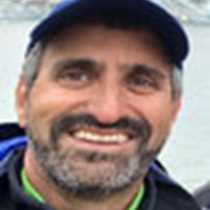Bilbao, Basque Country, Spain
Today we explored one of the world’s most imaginative and exciting buildings - the Guggenheim Museum Bilbao. The titanium and glass expression of modernism demonstrates the forward thinking of the historic Basques. Possibly descendants of Cro-Magnons and speakers of Europe’s only untraceable language, Basque nationals envision Frank O. Gehry’s architectural achievement as a bold statement of identity and revitalization. Indeed the heavy industrial port of Bilbao has been given newfound artistic inspiration by the Guggenheim creation and heightened tourism and awareness of Basques have followed.
The swirling metallic monument sits cleverly integrated in an urban riverside, as if an abstract whale has hauled up out of the water or a spaceship has landed in the valley. A giant spider and giant dog stand guard outside. (The locals mockingly called the silvery building “the sardine can” after the local fishery; but since Koons’ flower puppy statue was installed they prefer “the doghouse”.) Currently two huge building-size silver boxes covered in prismatic holographic panels sit outside reflecting and refracting light in harmony with the museum’s shiny surfaces. Every hour a fog sculpture emits condensed vapor over the reflecting pool to the edge of the titanium.
Within the museum’s galleries and naturally lit atria are Calder mobiles, video art installations and temporary exhibitions by Rothko and Rosenquist. Large works by Rauschenberg, Warhol, Lichtenstein and Dine make up a Pop art exhibit. While the works of art stand on their own merit, they are consumed by their home, a creation of changing light, angles and vistas.
The interplay of modern art within the flowing spaces and the juxtaposition of futuristic architecture in urbanity are striking impressions, yet it is the addition of the outrageously modern Guggenheim Museum to the Basque cultural panorama of nationalism, religion, seafaring and industry that makes a visit to Bilbao cause for reflection.
Today we explored one of the world’s most imaginative and exciting buildings - the Guggenheim Museum Bilbao. The titanium and glass expression of modernism demonstrates the forward thinking of the historic Basques. Possibly descendants of Cro-Magnons and speakers of Europe’s only untraceable language, Basque nationals envision Frank O. Gehry’s architectural achievement as a bold statement of identity and revitalization. Indeed the heavy industrial port of Bilbao has been given newfound artistic inspiration by the Guggenheim creation and heightened tourism and awareness of Basques have followed.
The swirling metallic monument sits cleverly integrated in an urban riverside, as if an abstract whale has hauled up out of the water or a spaceship has landed in the valley. A giant spider and giant dog stand guard outside. (The locals mockingly called the silvery building “the sardine can” after the local fishery; but since Koons’ flower puppy statue was installed they prefer “the doghouse”.) Currently two huge building-size silver boxes covered in prismatic holographic panels sit outside reflecting and refracting light in harmony with the museum’s shiny surfaces. Every hour a fog sculpture emits condensed vapor over the reflecting pool to the edge of the titanium.
Within the museum’s galleries and naturally lit atria are Calder mobiles, video art installations and temporary exhibitions by Rothko and Rosenquist. Large works by Rauschenberg, Warhol, Lichtenstein and Dine make up a Pop art exhibit. While the works of art stand on their own merit, they are consumed by their home, a creation of changing light, angles and vistas.
The interplay of modern art within the flowing spaces and the juxtaposition of futuristic architecture in urbanity are striking impressions, yet it is the addition of the outrageously modern Guggenheim Museum to the Basque cultural panorama of nationalism, religion, seafaring and industry that makes a visit to Bilbao cause for reflection.




